Trees With Long Seed Pods – Identification Guide (With Pictures)

Trees with long, slender seed pods are easily identified in woodlands and parks. The distinctive bean-like pods may look like a string of pearls, long flattened brown cases, or slender cylindrical seed pods measuring up to 24” (60 cm) long. Many of these trees with long seed pods are in the bean family Fabaceae and have similar seed cases containing several round or oval seeds.
Catalpa trees are the most commonly identifiable trees with long seed pods dangling from branches. Other trees known for their long flattened or cylindrical seed-filled pods include black locust, eastern redbud, palo verde, mimosa, and trumpet trees. Depending on the species, the long seed pods can measure between 4” and 24” (10 – 60 cm) in length.
This article explores some of the most fascinating trees with long seed pods. From the iconic catalpa tree to locust, redbud, and coffee trees, we will examine the characteristics of each tree to identify the tree species.
Trees With Long Seed Pods (Pictures and Identification)
Let’s look in detail at the most common trees with long seed pods.
Catalpa Trees (Catalpa)
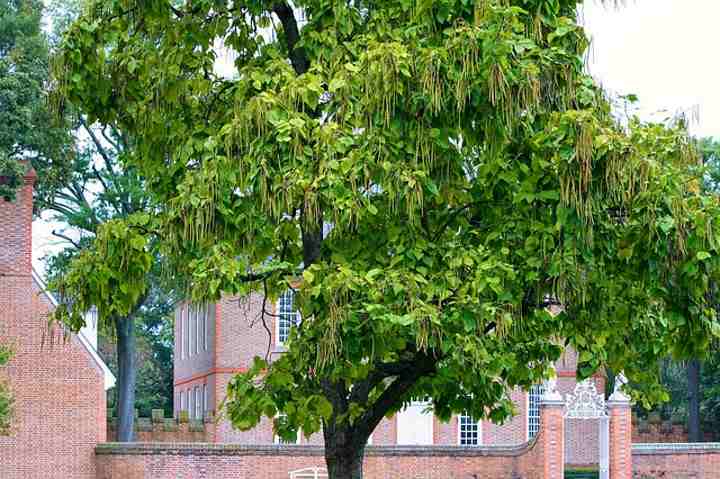
Catalpa tree is identified by its long and slender seed pods
Catalpa trees have some of the longest seed pods you will likely find on trees. These ornamental deciduous trees have long, pencil-like pods that grow between 8” and 24” (20 – 60 cm) long.
The slender brown seed pods dangle from branches and persist through winter. On a leafless tree, the long slender pods look like brown icicles.
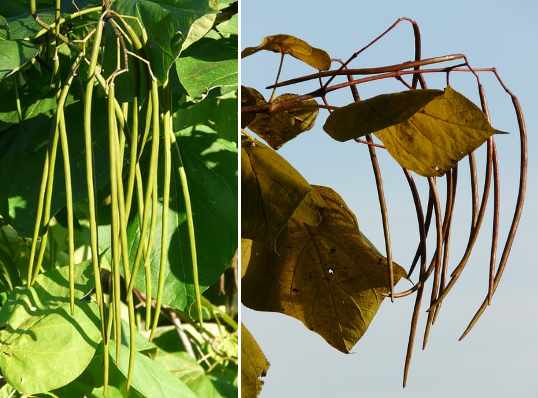
Immature green catalpa seed pods (left) and mature brown seed pods (right)
Northern Catalpa (Catalpa speciosa)
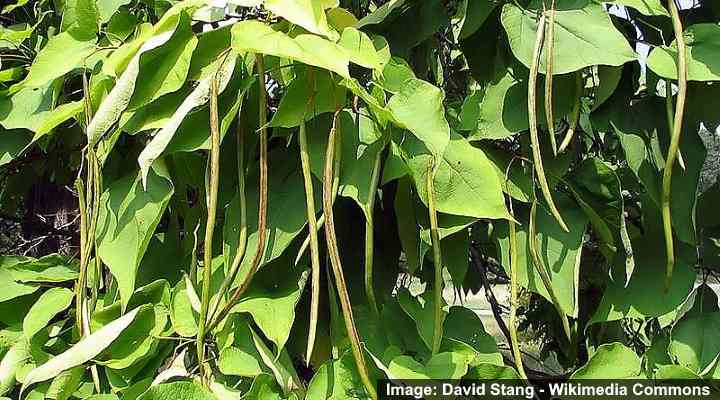
Northern catalpa leaves and seed pods
Long, thin cylindrical seed pods grow on the northern catalpa tree. The bean-like capsules emerge green and turn brown as they ripen in fall.
Each pencil-thin pod of the northern catalpa tree measures 8” to 20” (20 – 50 cm) long and is filled with flat, light brown winged seeds measuring 1” (2.5 cm) long.
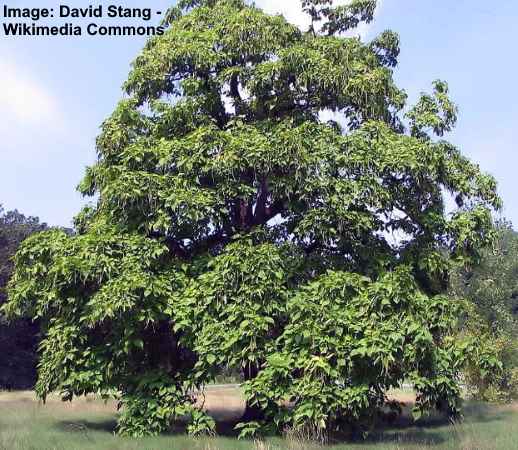
Northern catalpa tree (Catalpa speciosa)
The northern catalpa is a large-sized deciduous tree native to North America. Apart from the long green-bean-like seed pods, the tree is identified by its white, trumpet-shaped flowers and heart-shaped leaves measuring 8” to 12” (20 – 30 cm) long.
The northern catalpa trees grow 50 to 100 ft. (15 – 30 m) tall with an irregular canopy 40 ft. (12 m) wide.

Northern catalpa flowers and leaves
Due to the catalpa tree’s long, thin brown seed pods, it’s also called the cigar tree.
Southern Catalpa (Catalpa bignonioides)
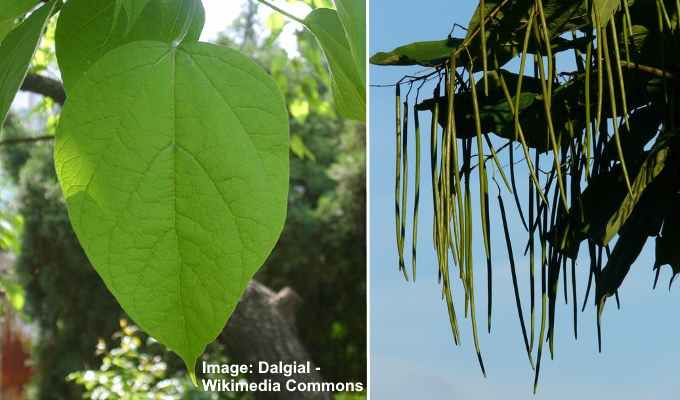
Southern catalpa leaf and seed pods
Long slender seed capsules are an identifying feature of the southern catalpa tree. These brown bean pods are slightly flattened and measure 6” to 20” (15 – 50 cm) long and 0.3” to 0.4” (0.8 – 1 cm) in diameter.
Like the northern catalpa, the rounded pods of the southern catalpa tree emerge green before turning brown in fall. They persist on the tree through winter.
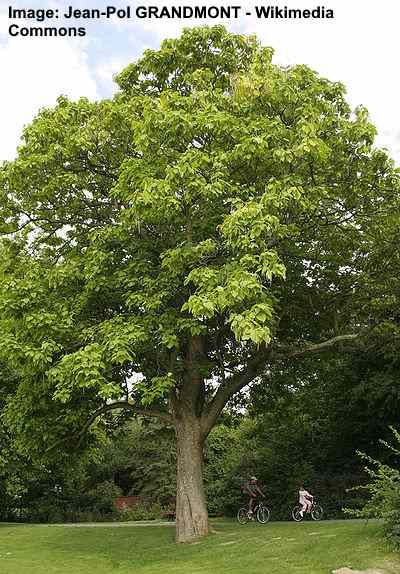
Southern catalpa (Catalpa bignoniodes)
Other identifying features of the southern catalpa are its clusters of small funnel-shaped white flowers, large leaves measuring up to 10” (25 cm) long, and reddish-brown bark.
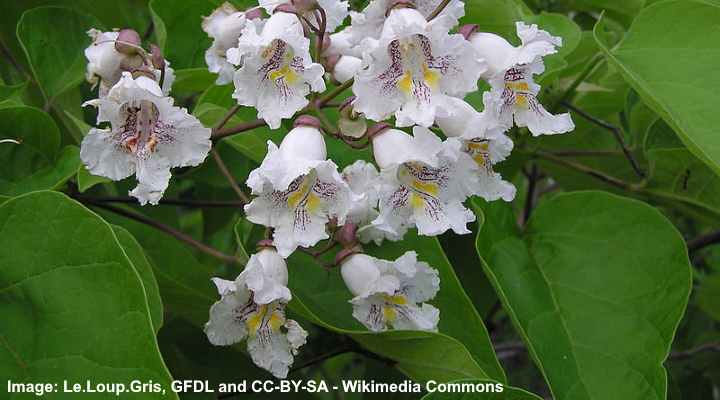
Southern catalpa flowers
The southern catalpa is difficult to distinguish from the northern variety. However, comparing the long seed pods and flowers, you’ll notice that the southern catalpa fruit and blossoms are slightly smaller.
Honey Locust Tree (Gleditsia triacanthos)
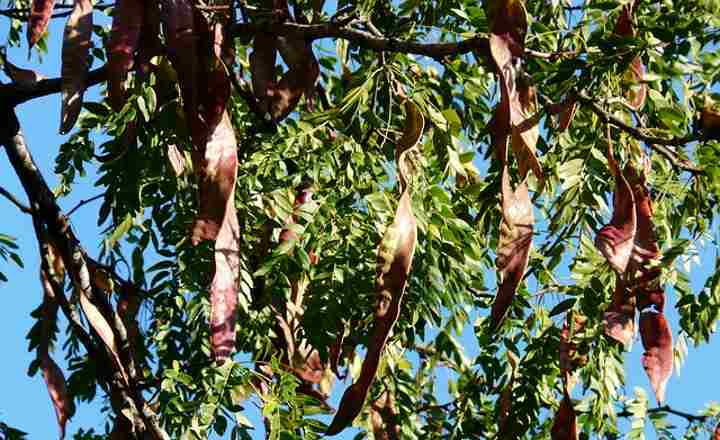
The long seeds of the honey locust tree are flat and twisted
The honey locust tree is a fast-growing, hardy tree known for its long, reddish-brown, flattened seed pods.
The easily identifiable slender pods of the honey locust tree measure 18” (45 cm) long and have a twisted shape. An unusual feature of the long brown seed pods is their honey-like, sweet pulp that matures in early fall.
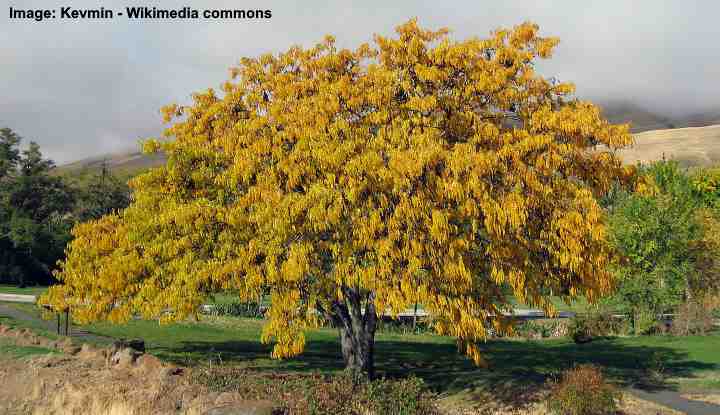
Honey locust tree (Gleditsia triacanthos)
Also called the thorny locust tree, the deciduous tree is native to North America. One of the characteristics of the locust tree is its thorny trunk and branches. The stiff, sharp spines on the tree grow in dense clumps.
Honey locust trees have finger-like clusters of fragrant yellow flowers and pinnately compound feathery leaves.

Honey locust leaves and flowers
Honey locust trees with huge brown seed pods grow 65 to 100 ft. (20 – 30 m) tall.
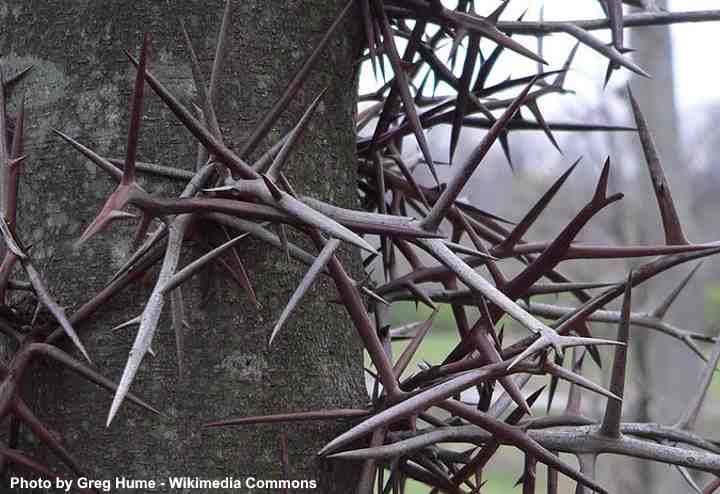
Honey locust bark and thorns
Black Locust Tree (Robinia pseudoacacia)
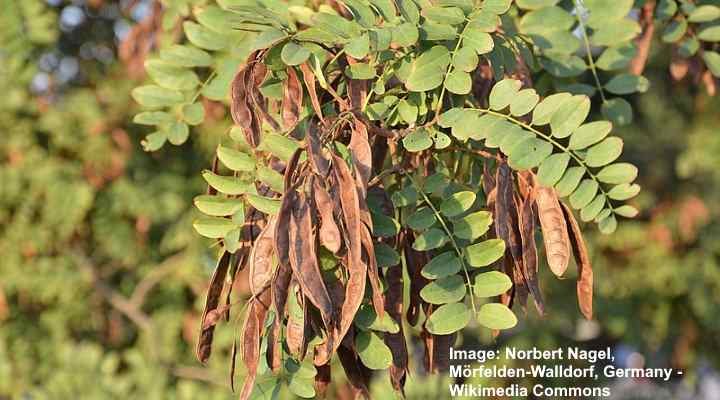
Black locust tree seed pods
The black locust tree is a fast-growing, deciduous tree with flat, purplish-brown bean-like pods.
Each long, thin seed pod of the black locust tree measures 2” to 4” (5 – 10 cm) long and up to 0.5” (1.3 cm) wide. The long dark brown pods contain several dark orange-brown seeds that ripen in late fall.
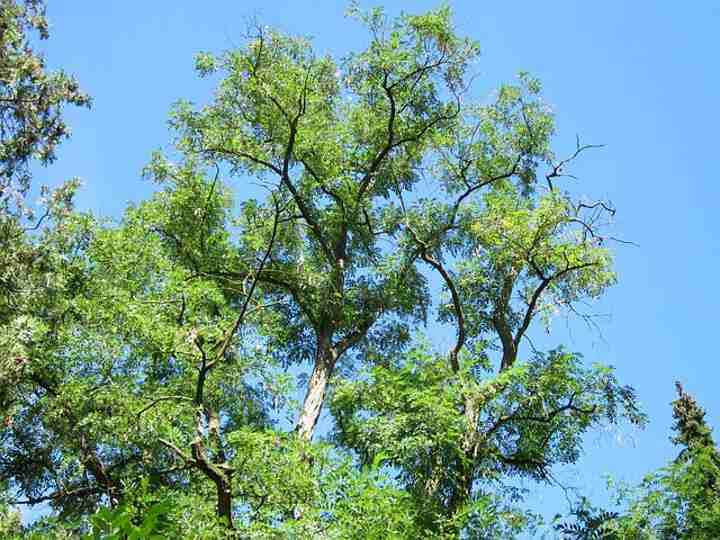
Black locust tree
One of the attractive features of the black locust tree is its fragrant white flowers. The loose clusters of white blossoms grow up to 8” (20 cm) long and bloom in late spring or early summer.
Leaves on the black locust tree are dark green and consist of small leaflets growing on stems.
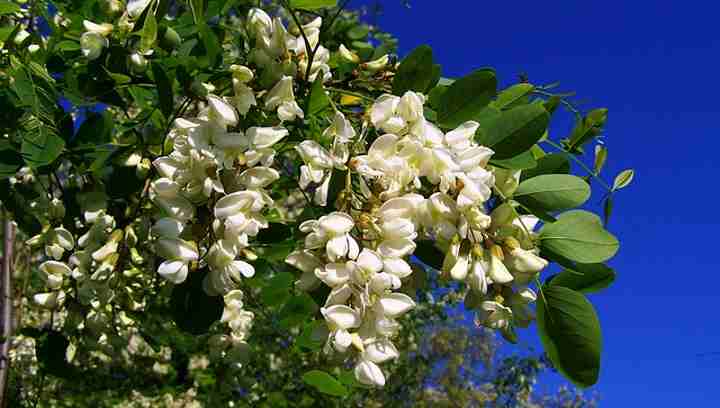
Flowers and leaves of black locust tree
Fast-growing black locust trees grow 30 to 50 ft. (9 – 15 m) tall and up to 35 ft. (10.5 m) wide.
Eastern Redbud Tree (Cercis canadensis)
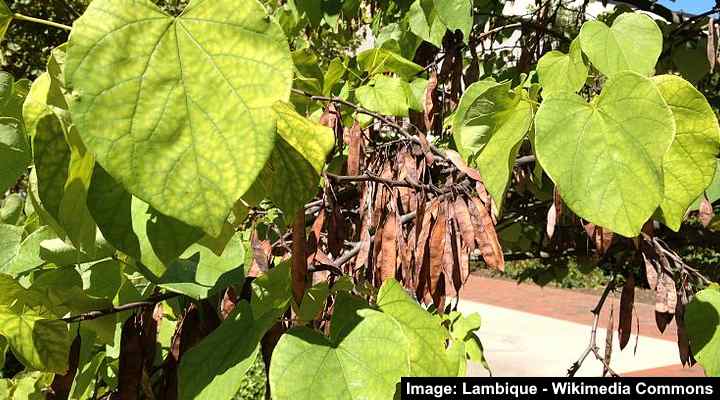
Eastern redbud seed pods and leaves
The eastern redbud tree is a beautiful ornamental, pink-flowering tree with brown, bean-like seed pods in the fall.
Eastern redbuds are known for the masses of pea-like rosy-pink and purple spring blossoms. After blooming, the pink flowers give way to long brown flat seed pods 2” to 4” (5 – 10 cm) long.
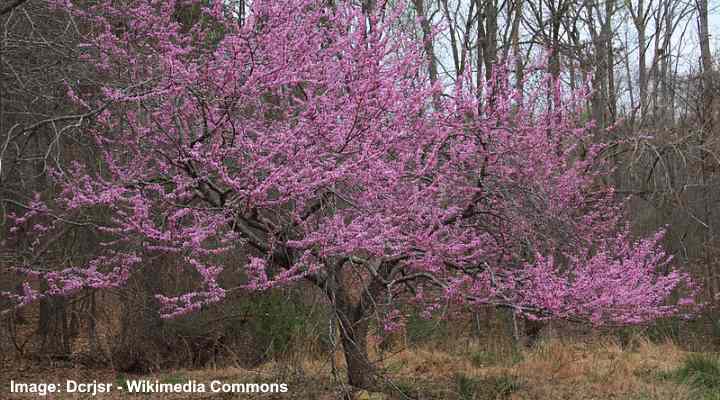
Eastern redbud tree with pink flowers
Long seed pods on eastern redbud trees contain small pea-like seeds 0.25” (0.6 cm) long.
After the tree’s heart-shaped green leaves drop in the fall, the dangling brown pods provide visual interest throughout winter. Redbuds are small ornamental trees growing 20 to 30 ft. (6 – 9 m tall).
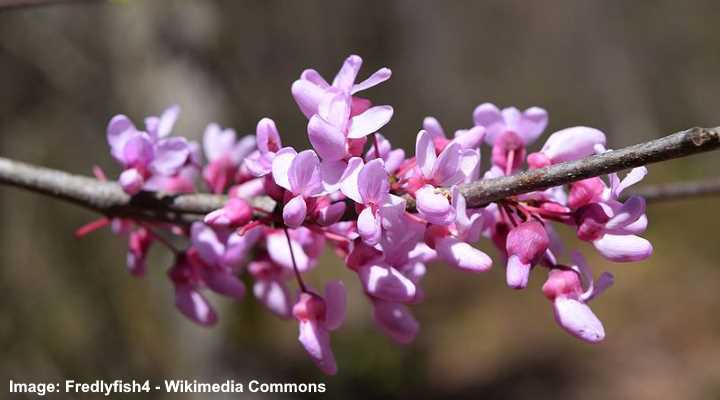
A close up picture of Eastern redbud flowers
Additionally, eastern redbud trees are easy to care for and maintain, adding value and beauty to any landscape in USDA zones 4 to 9.
Judas Tree (Cercis siliquastrum)
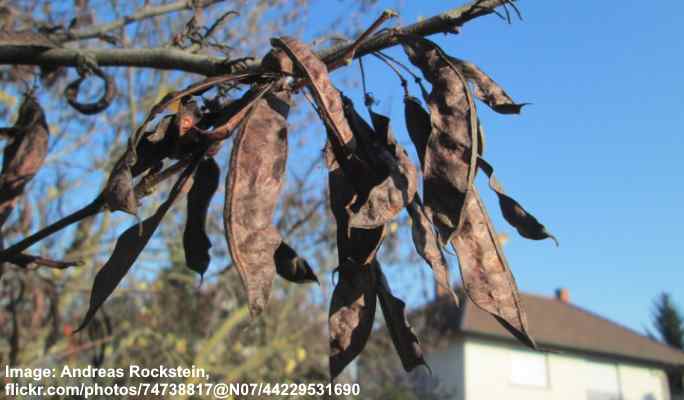
Judas tree seed pods
The Judas tree produces masses of brownish-purple seed pods measuring 4” (10 cm) long.
These flattened purplish seed casings appear in summer and persist through winter. Also known for its abundant rosy-purple clusters of spring flowers on bare branches, the ornamental tree adds beauty and shade to a landscape.
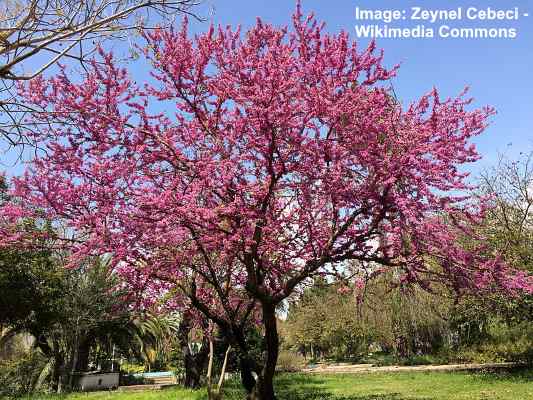
Judas tree (Cercis siliquastrum)
The pink-flowering Judas tree grows 15 to 25 ft. (4.5 – 7.5 m) tall and wide. In addition to its attractive deep pink flowers and dangling showy seed pods, the tree features heart-shaped leaves.
These seed pods emerge red in the spring, mature to green, and turn yellow or brown in the fall.
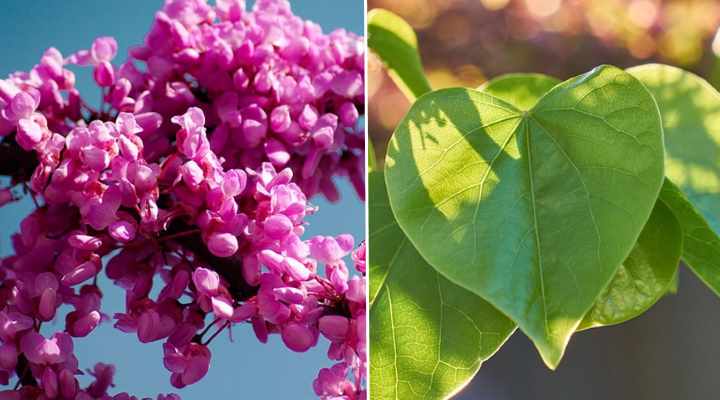
Judas tree flowers and leaves
Mimosa Tree (Albizia julibrissin)

Mimosa tree seed pods
Also known as the silk tree, the mimosa tree produces brown, flat elongated seed pods 4” to 8” (10 – 20 cm) in length. In addition to its flattened bean pods, the tree is identified by its pom-pom-like clusters of pink flowers.
Each mimosa tree bloom consists of silky threads that look like fluffy pink powder puff.
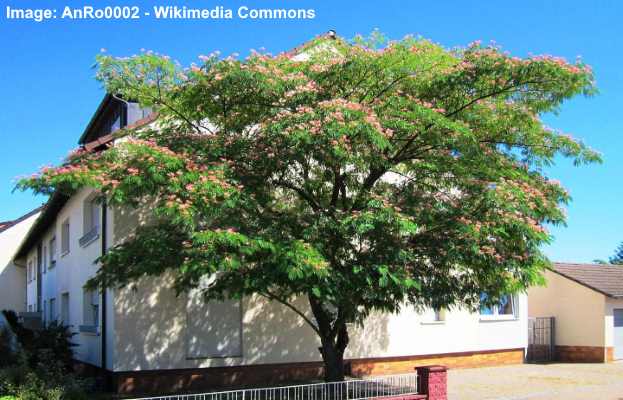
Mimosa tree (Albizia julibrissin)
The fast-growing mimosa tree grows 20 to 40 ft. (6 – 12 m) tall and up to 50 ft. (15 m) wide.
Apart from its flat seed pods and fluffy pink flowers, the deciduous tree has attractive fern-like foliage consisting of 20” (50 cm) long bipinnate leaves.
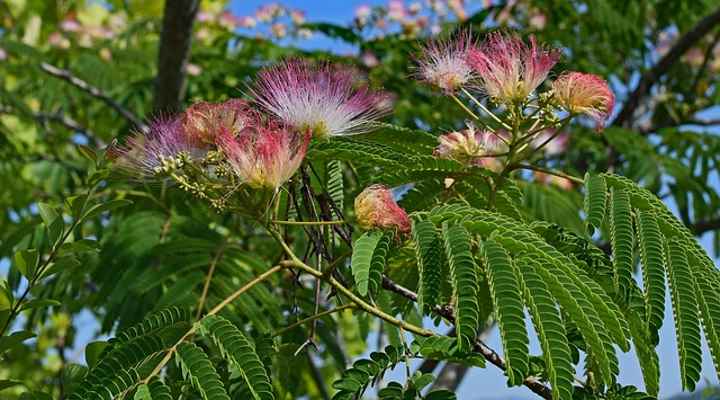
Mimosa tree flowers and leaves
Mimosa trees are drought-tolerant and low maintenance and add a touch of elegance and beauty to a subtropical landscape.
Cape Wattle (Paraserianthes lophantha)
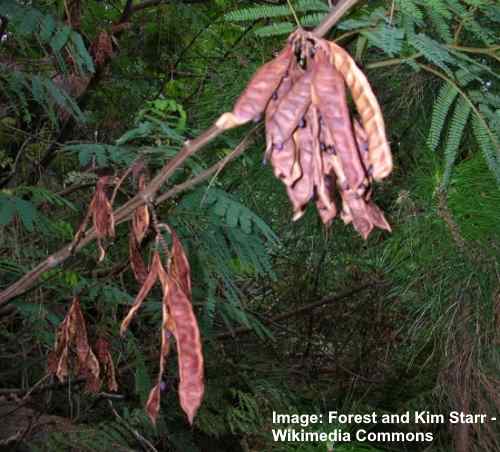
Cape wattle seed pods
Cape wattle is a fast-growing shrub or small tree with clusters of dark seed pods measuring 4” (10 cm) long. The smooth, flattened pale brown seed casings contain several black seeds.
The Cape wattle seed pods follow pale greenish-yellow bottlebrush flowers that appear in early summer and persist through winter.
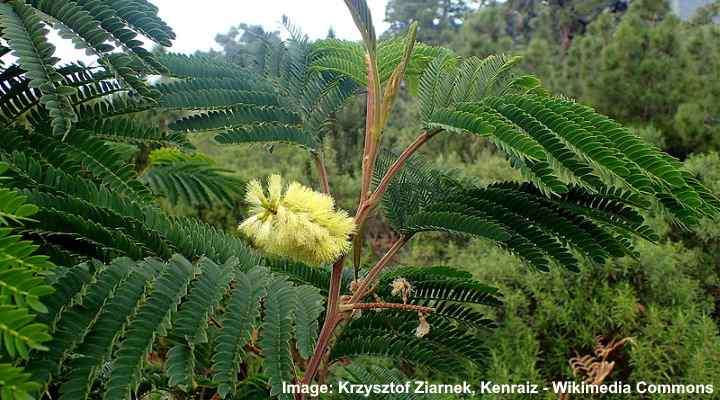
Cape wattle flower and leaves
Also known as fernleaf wattle, crested wattle, or plume albizia, this unusual tree can be found on the west coast of the US. The small shrub-like tree grows up to 40 ft. (12 m).
Apart from its flattened brown curled seed pods, the fernleaf wattle tree has fern-like foliage like the mimosa tree.
Palo Verde Tree (Parkinsonia florida)
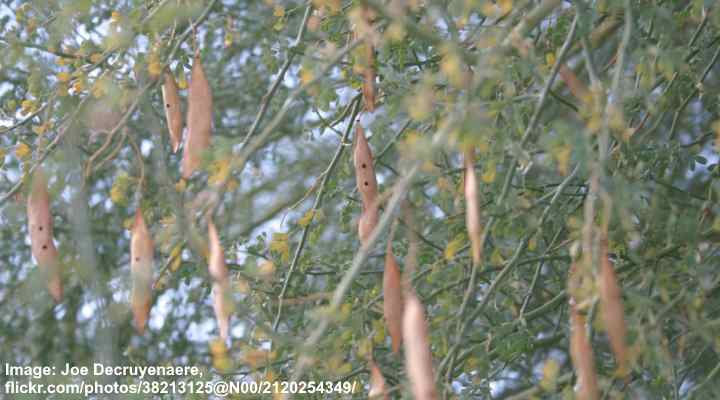
Palo verde seed pods
The Palo verde tree is a sun-loving desert tree known for its flat, thin, seed pods with pointed ends.
Each flattened brown pod of the Palo verde tree contains two large brown seeds. The pods’ tan color contrast with the tree’s green branches and stems. The long brown seed pods measure 2” to 3” (5 – 7.5 cm) long.
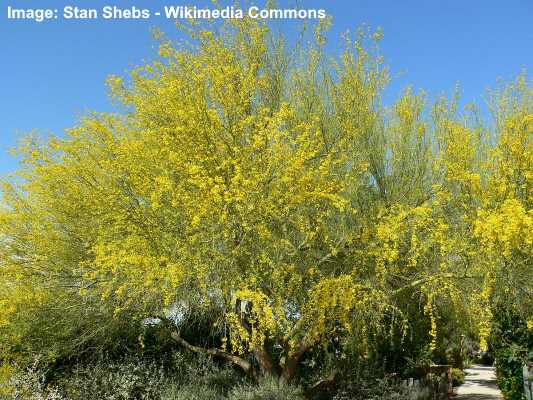
Palo verde tree in bloom
The eye-catching features of the palo verde tree are its green bark, bright golden-yellow spring flowers, and small bluish-green leaves.
Palo verde is tolerant of drought, heat, and arid conditions. The ornamental tree grows 20 to 25 ft. (6 – 7.5 m) tall and up to 20 ft. (6 m) wide.

Palo verde bark
Royal Poinciana Tree (Delonix regia)
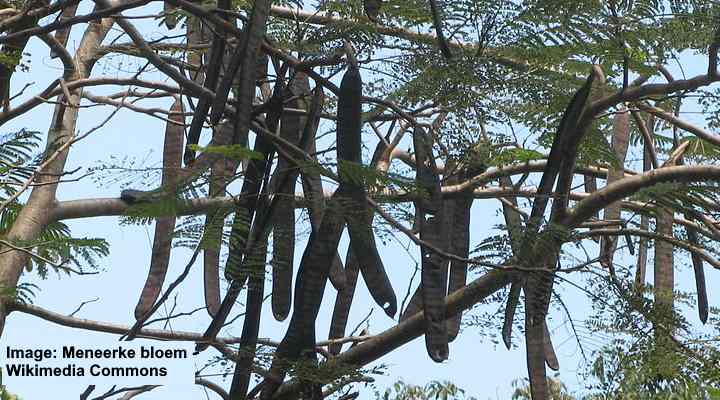
Royal poinciana seed pods
The royal poinciana tree is a stunning tropical tree known for its huge brown seed pods and fiery red-orange flowers.
Popular in Florida landscapes, the royal poinciana tree produces flattened, brown or black seed pods measuring up to 24” (60 cm) long. Each stiff, strap-like pod can hold up to 50 seeds.
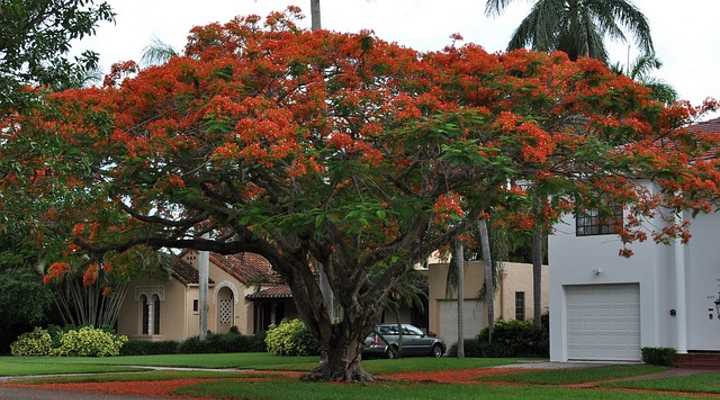
Royal poinciana (Delonix regia) tree
The most attractive feature of the royal poinciana tree is its large clusters of brilliantly colored red or orange flowers. The tropical flowers have four spoon-shaped petals measuring 3” (7.5 cm) long.
When in bloom during summer, masses of vibrant flowers cover the tree’s spreading, rounded canopy.
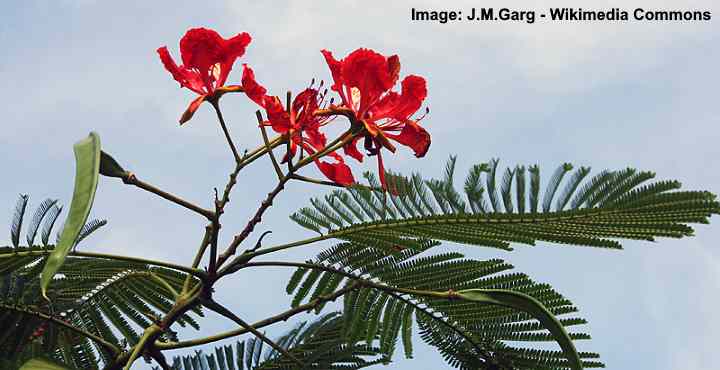
Royal poinciana flowers and leaves
Royal poinciana trees grow 30 to 65 ft. (9 – 20 m) tall and have a spreading canopy up to 60 ft. (18 m) wide.
Kentucky Coffee Tree (Gymnocladus dioicus)
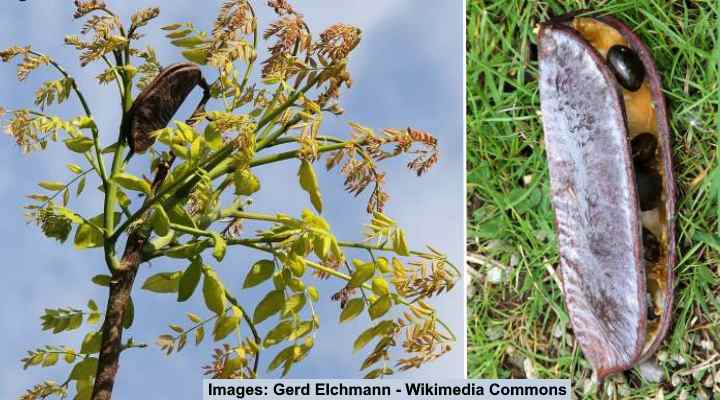
Kentucky coffee tree seed pods
The Kentucky coffee tree is a slow-growing deciduous tree with long, flat seed pods and small leaves. The attractive reddish-brown bean pods grow in clusters and measure 10” (25 cm) long and up to 3” (7.5 cm) wide.
Leaves of the Kentucky coffee tree are bipinnately compound with up to nine pairs of small leaflets on leaves 3 ft. (1 m) long.
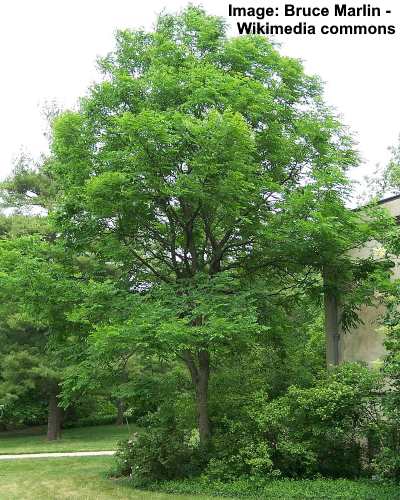
Kentucky coffee tree (Gymnocladus Dioicus)
The Kentucky coffee tree is characterized by its dark brown, fissured bark, zig-zag stems, and purplish-brown pods containing oval seeds.
Traditionally, the seeds are roasted and used as a coffee substitute—hence the name coffee tree.

Kentucky coffee tree leaves
Kentucky coffee trees grow 60 to 80 ft. (18 – 24 m) tall and up to 55 ft. (17 m) wide. They are excellent shade trees for large landscapes, and their large brown seed pods create visual appeal in the winter. However, they can become messy when they drop.
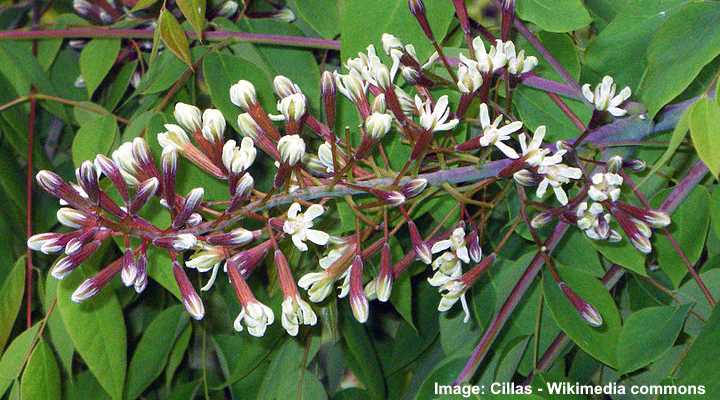
Kentucky coffee tree flowers
Acacia Tree (Acacia)
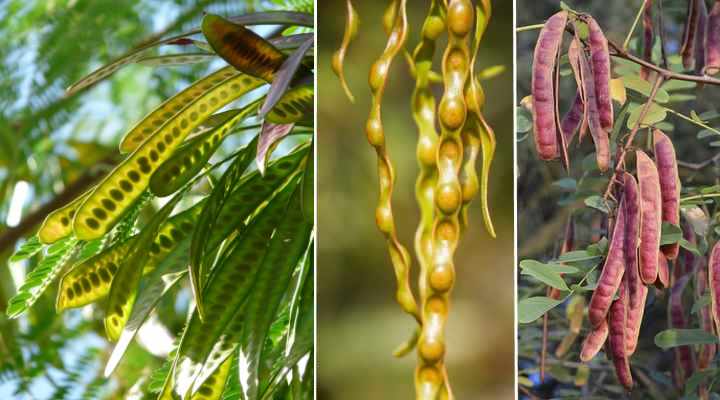
Acacia seed pods have various shapes and colors depending on the species
Acacia trees are a group of sun-loving thorny trees that produce clusters of long seed pods. Depending on the tree species, acacia seed pods can be twisted, straight, or coiled. Some of the long, seed-filled elongated pods can have a fuzzy texture.
The acacia tree pods contain red seeds, and the pods can be brown, black, or green and measure between 2.8” and 8” (7 – 20 cm) long.
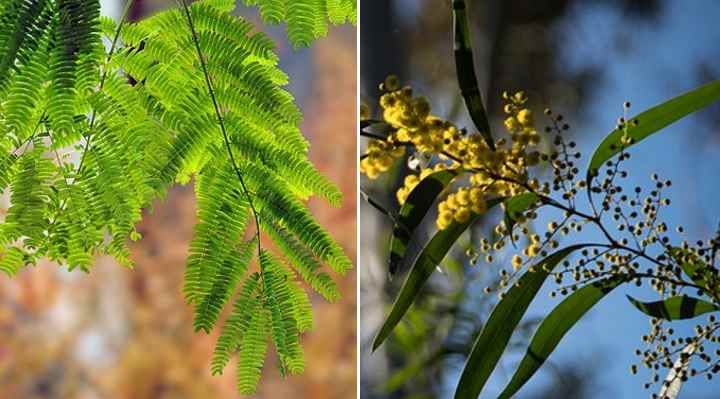
Acacia leaves can be fern-like bipinnate (left) or flattened petioles that act like leaves (right)
Apart from the colorful seed pods, attractive features of acacia trees are their feathery fern-like foliage and strikingly beautiful flowers that look like white or yellow puffballs. Acacia trees grow between 20 and 50 ft. (6 – 15 m).
These trees are suitable for use as shade trees in hot climates.
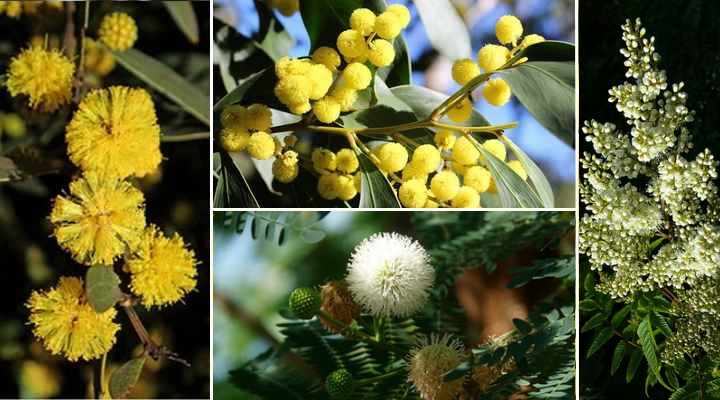
Acacia flower clusters are mainly yellow or creamy-white and have fuzzy appearance
Desert Willow (Chilopsis linearis)
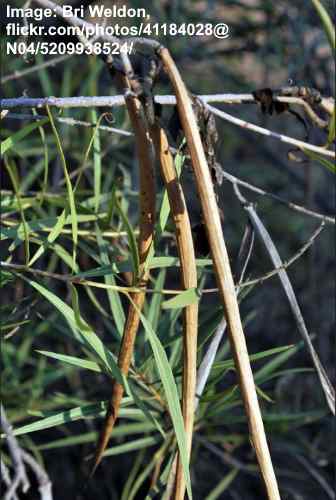
Desert willow seed pods
Desert willow is a small to medium-sized shrub-like tree known for its showy, trumpet-shaped pink flowers and long, linear seed pods. The slender seed pods grow 6” to 10” (15 – 25 cm) long and contain several winged seeds.
The tree’s showy funnel flowers thrive in hot, dry climates, making the tree an ideal desert plant.
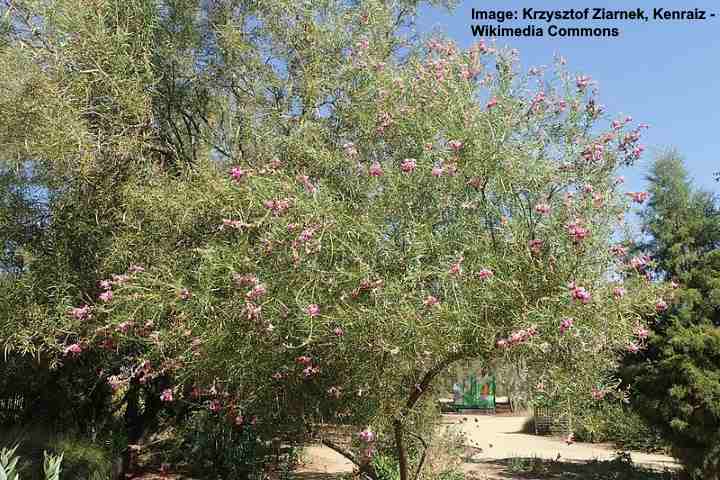
In this picture: Chilopsis linearis ‘Timeless Beauty’
Desert willows look stunning in arid landscapes when the large purple, pink, or white flowers bloom from May through September. The tree is also identified by its willow-like leaves and huge elongated seed pods that persist through winter.
Desert willow grows 15 to 40 ft. (4.5 – 12 m) with an open, spreading crown.
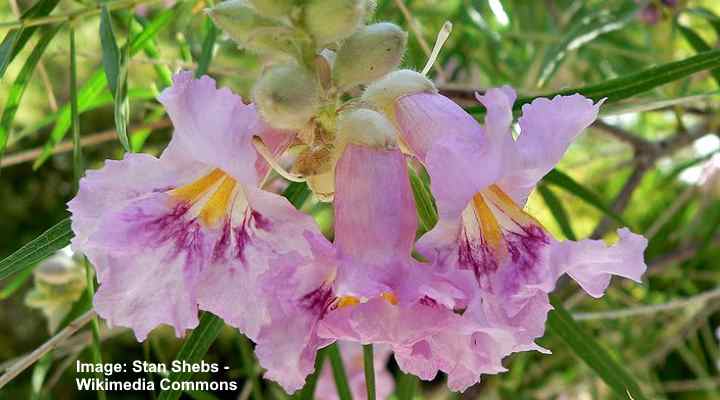
Desert willow flowers
Trumpet Trees (Tabebuia)
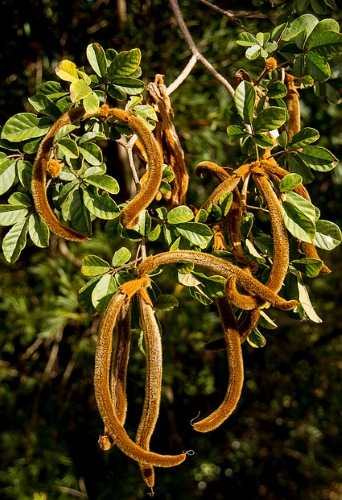
Golden trumpet tree (Tabebuia chrysotricha) seed pods
Trumpet trees are a tropical tree species that are famed for their showy trumpet-shaped flowers in shades of pink, yellow, and purple. After blooming, trumpet trees produce long, slender brown pods in a banana or cigar shape.
Depending on the tree species, the seed pods can measure between 3” and 12” (7.5 – 30 cm).
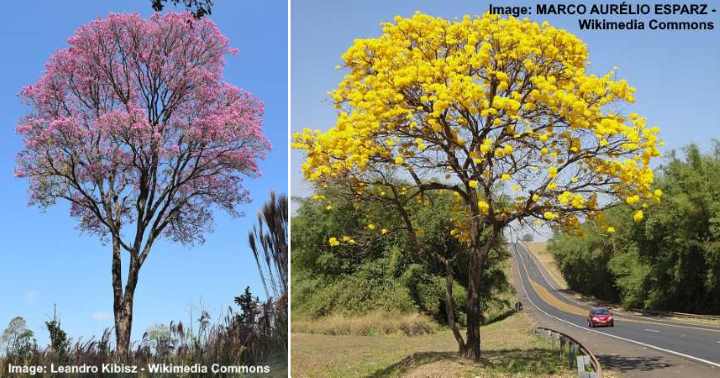
Tabebuia trees. Left: Purple trumpet tree (Tabebuia impetiginosa). Right: Golden Trumpet Tree (Tabebuia chrysotricha)
Trumpet trees have moderate growth and can reach heights of 20 to 40 ft. (6 – 9 m) tall. The colorful trumpet-shaped flowers can measure 1” to 4” (2.5 – 10 cm) long and bloom in early spring on bare branches.
Yellow Bells (Tecoma stans)
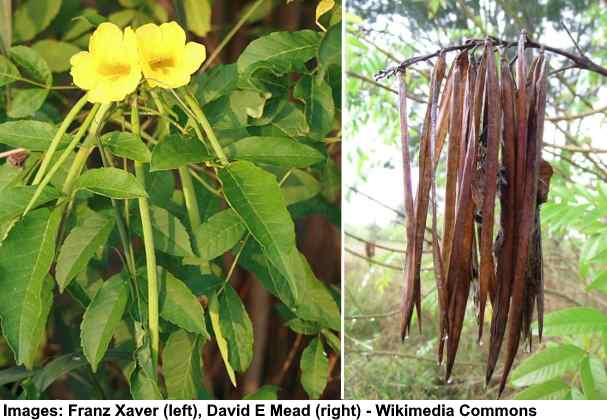
Immature and mature yellow bells seed pods
Yellow bells is an eye-catching shrub-like small tree with clusters of showy yellow trumpet flowers, lush foliage, and many string-like long seed-filled pods. The slender bean pods grow 8” (20 cm) long and contain numerous winged seeds.
These blow away when the seed pods ripen, crack open, and release the seeds.

Yellow bells flowers and leaves
Although the narrow seed pods provide some visual interest, it’s the stunning brightly-colored yellow flowers that are attractive. Flowering continuously from spring until late fall, the fragrant yellow blossoms add plenty of color to a subtropical landscape.
The shrubby plant grows 10 to 25 ft. (3 – 8 m) tall and up to 20 ft. (6 m) wide.
Amur Maackia (Maackia amurensis)
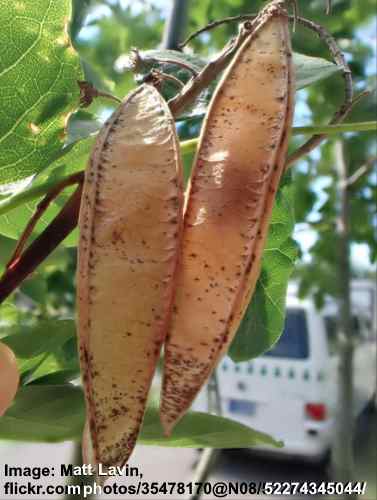
Amur maackia seed pods
Amur maackia is a deciduous slow-growing tree with flat seed pods, fragrant, white pea-like blossoms, and attractive coppery-bronze bark.
The Amur maackia tree’s flat bronze-colored seed pods measure 2” to 3” (5 – 7.5 cm) long. Its white flower clusters are dense panicles growing up to 8” (20 cm) long.
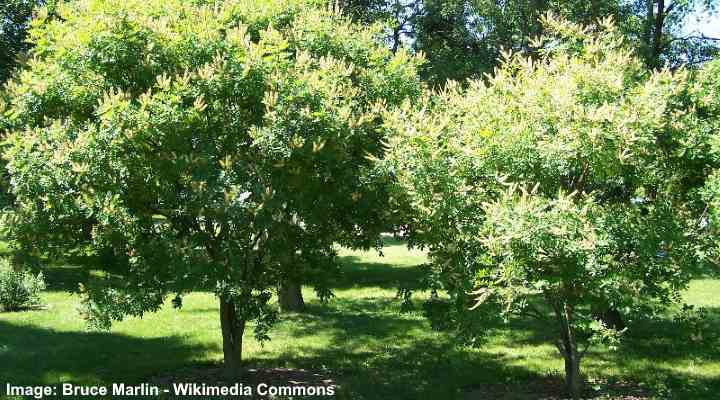
Amur maackia (Maackia amurensis) trees
This ornamental Amur maacikia tree is known for its stunning white flowers that bloom in mid-summer. Useful as a shade tree or lawn tree in temperate climates, the hardy broadleaf tree grows 20 to 30 ft. (6 – 9 m) tall and wide.
After its leaves drop in the fall, peeling cinnamon bark and brown seed pods provide visual winter interest.
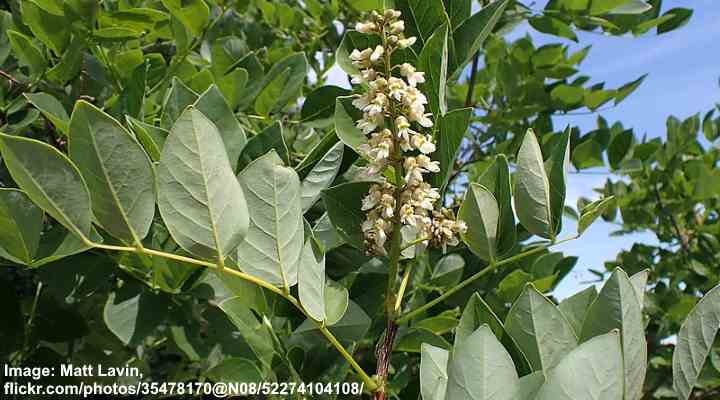
Amur maackia flowers and leaves
Purple Orchid Tree (Bauhinia variegata)
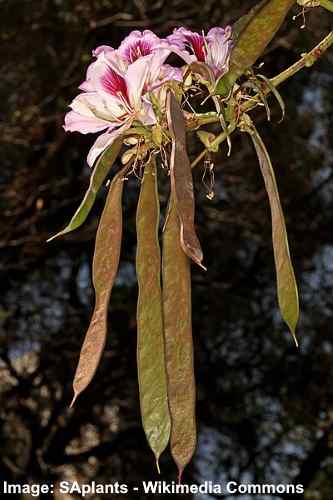
Purple orchid tree seed pods
The purple orchid tree is a magnificent flowering tree with flat, sharply pointed seed pods and stunning orchid-like flowers.
The deciduous small shrub-like purple orchid tree blossoms in winter with clusters of five-petaled pink, white, or purple flowers. These are followed by flattened strap-like seed pods measuring 12” (30 cm) long.
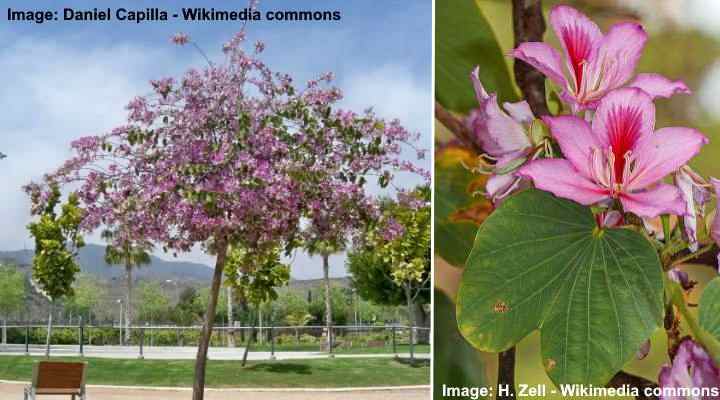
Purple orchid tree, flowers and leaves
The sun-loving purple orchid tree thrives in tropical landscapes in USDA zones 9 to 11. Sometimes growing as a large shrub, the multi-stemmed tree can grow 20 to 35 ft. (6 – 10.5 m) tall. In the right climate, the pink-flowering tree is ideal as a specimen shrub, small shade tree, or border plant.
Carob Tree (Ceratonia siliqua)

Carob tree seed pods
The carob tree is an evergreen tree that produces long edible seed pods. The legume seed-filled fruit can be relatively thick with a curved or straight shape. Carob pods turn from green to a glossy dark brown, almost black, as they ripen.
The sweet leguminous pods grow 4” to 10” (10 – 25 cm) and contain eight to 12 seeds.
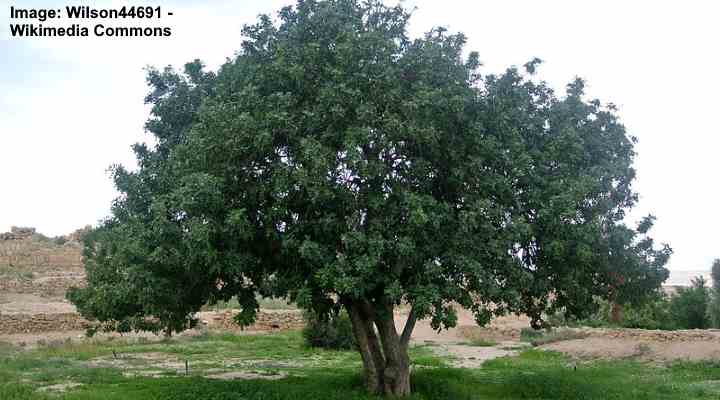
Carob tree (Ceratonia siliqua)
The carob tree is native to Mediterranean regions and grows up to 50 ft. (15 m) tall and wide. The term carob comes from Greek, meaning horn-shaped, and refers to the shape of the large curved seed pods. The drought-tolerant trees are ideal for hot climates and xeriscaping.
Related articles:
